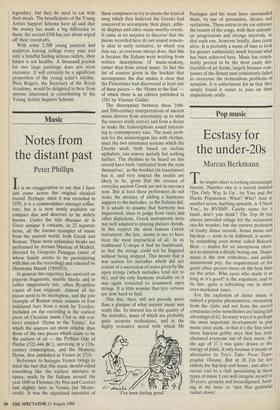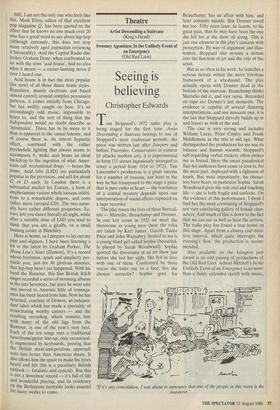Pop music
Ecstasy for the under-20s
Marcus Berkmann
The singles chart is looking increasingly bizarre. Number one is a record entitled `The Only Way Is Up', by Yass and the Plastic Population. What? Who? And at number seven, hurtling upwards, is 't Need You', by BVSMP. Catchy name for a band, don't you think? The Top 40 has always provided refuge for the occasional one-hit wonder, but the current profusion of trashy dance records, house music and hip-hop — soon to be followed, it seems, by something even worse called Balearic Beat — makes for an anonymous chart, not to mention a deeply boring one. Dance music is the new orthodoxy, and unlike mainstream pop, the requirements of the genre place greater stress on the beat than on the artist. Who cares who made it as long as it's good? is the argument, and to be fair, quite a refreshing one in these over-marketed times.
For the explosion of dance music is indeed a popular phenomenon, emanating from the clubs and not from the record companies (who nonetheless are taking full advantage of it). In many ways it is perhaps the most important development in pop music since punk, in that it's the first since those halcyon gobby days that has truly alienated everyone out of their teens. At the age of 17 I was quite drawn to the energy of punk, if only because it meant an alternative to Yes's Tales From Topo- graphic Oceans. But at 28 I'm far too elderly for hip-hop and house, and after a recent visit to a club specialising in these types of music I can well imagine myself in 20 years, grouchy and becardiganed, bawl- ing at my heirs to 'turn that godawful racket down'. Still, I am not the only one who feels like this. Mark Ellen, editor of that excellent Pop magazine Q, has been quoted to the effect that he knows no one much over 20 who has a good word to say about hip-hop (although curiously, this does not stop many relatively aged journalists reviewing it favourably). And the Capital Radio disc jockey Graham Dene, when confronted on air with the term 'acid house', had no idea what it meant — a career-limiting move if ever I heard one.
Acid house is in fact the most popular (for now) of all those dance music styles. Repetitive, mainly electronic and based almost entirely around complex percussion patterns, it comes initially from Chicago, but has swiftly caught on here. It's an astonishingly odd music, impossible to listen to, and the sort of thing that the Independent would no doubt describe as `minimalist'. There has to be more to it than is apparent to the casual listener, and of course there is. Its almost hypnotic effect, combined with the rather psychedelic lighting that always seems to accompany it, make acid house an ideal backdrop to the ingestion of what Amer- icans call 'recreational drugs' — hence the name. Acid tabs (LSD) are particularly Popular in the provinces, and sell for about £2 or £3 each. In London there is a substantial market for Ecstasy, a form of amphetamine variant which loosens inhibi- tions to a remarkable degree, and costs rather more (around £20). The two natur- ally have rather different properties: Ec- stasy lets you dance literally all night, while after a suitable dose of LSD you tend to think that you are a giraffe, or a small housing estate in Bletchley.
Here at home, as I prepare to lay out my Pipe and slippers, I have been listening a lot to the latest by Graham Parker, The Mona Lisa's Sister (Demon). It's a record whose freshness, spark and simplicity per- suade you, just for 40 glorious minutes, that hip-hop hasn't yet happened. With his band the Rumour, this fine British R&B singer recorded a series of storming albums in the late Seventies, but since he went solo and moved to America little of consequ- ence has been heard from him. Now he has returned, courtesy of Demon, an indepen- dent label which has made a speciality of resuscitating worthy careers — and the resulting recording, which reunites him with many of the old lags from the Rumour, is one of the year's very best. Each of the ten songs uses a traditional bass/drums/guitar line-up, only occasional- ly augmented by keyboards, proving that the British meat-and-potatoes approach suits him better than American sheen. It also allows him the space to make his lyrics heard and felt (his is a peculiarly British outlook — fatalistic and cynical). But this is not a downbeat record — it's full of life and wonderful playing, and its residency on the Berkmann turntable looks assured for many weeks to come.























































 Previous page
Previous page